The Fascination With Miniature Reproductions
Description
This section is from the book "Make It And Make It Pay!", by Catherine Roberts. Also available from Amazon: Make It And Make It Pay.
The Fascination With Miniature Reproductions
An amazing number of people are intrigued and enchanted with miniature reproductions. Serious collectors and fond parents pour out hundreds of thousands of dollars annually for wee facsimiles of full-size period furnishings, silver, china, glassware and decorative accessories.
Every little girl, at some time or another, has tried her hand at making doll house furnishings. There are some older girls and women today who have made successful careers for themselves in the manufacturing of accessories scaled to the doll house or miniature room set-up. One woman specializes in making fruits and vegetables for the doll house kitchen. Others make doll families for display purposes. They are often used to dress up scale reproductions made by professional cabinet makers.
Stop and think for a moment of what is missing from those model rooms, those countless doll houses. Tiny pillows, bed quilts and sheets, rugs and curtains all are needed to increase the realistic effect that is desirable. Small towels simply have to hang in the bath and kitchen while a tablecloth and napkins must appear in the dining room. That scale model tester bed needs a quilt and dust ruffle as well as a canopy to make it completely beautiful and real looking.
Ninety-five per cent of the people interested in doll houses or model room set-ups have neither the time nor the ability to make these miniature accessories. Yet they want them. They want them badly enough to buy them. Your skill with the needle can be turned to advantage by specializing in making miniature decorative accessories. A few women and girls are already doing just exactly this. There is room for many, many more needlewomen who can produce tiny and beautiful articles.
The secret of perfection in this field is scaling. The size of good miniature furniture is scaled one inch to the foot. A miniature bed, scaled to size, would require a mattress one quarter inch thick, five and three quarter inches long and four inches wide, for a double bed. Sheets and quilts are figured on the size of the bed plus sufficient tuck-in, just like real bed linen. A living room rug might be nine inches by twelve inches.
Knowing the scale to which miniature furniture is made simplifies the making of decorative accessories. On the other hand, commercially made doll houses, designed for toys, rarely conform to standard measurements or scaling. It becomes, therefore, an absolute necessity to take exact measurements for everything to be made. This may seem like a nuisance but the final perfect results will more than repay you for the initial trouble taken.
Ranking in importance with scale is the fabric to be used. The softer it is the better. Collect old linen handkerchiefs and infants dresses. Try dyeing your own materials. Wash all new materials before they are cut and sewn, if they are not pliable enough to fall in soft and graceful folds. Use only very tiny prints and pin stripes and the smallest of checks. Try painting your own small designs on the materials used for draperies and upholstery. Keep everything in the way of pattern as small as you can.
Use only the finest and smallest of hand stitching when making up the accessories. A #90 cotton and a size 10 needle will aid in dainty and minute sewing. Press everything as it is completed, using a small travelling iron if you have one. If the articles are being sold, wrap each one in fresh white tissue.
Miniature rugs are very desirable accessories. Those that are fine and beautifully made command relatively high prices. Very simple and effective ones can be made from pieces of wool felt, cut to size, and fringed with fine knitting wool. Heavy cotton string, dyed in the desired colors, may be braided, or chained with a crochet hook, then sewn together in round, oval or oblong shapes.
The most beautiful of all miniature rugs, used only in the living room with really fine furniture, are those made of needlepoint embroidery. Because they are small in size, they don't take too long to make. They are so lovely that they are worth the skill and effort involved. (See page 94 for design suggestions). Needlepoint may also be used for miniature footstools, tops of sofa cushions and chair pads.
Directions for making some of the standard decorative accessories are given, with illustrations, on page 95 and 96. When they have been completed successfully, try out some of your own decorative ideas, always keeping in mind the factor of scaling.
Doll House Petit Point Rug
Draw design on needlepoint canvas with sharp crayon pencil. Zephyr yarn is used to make the tiny petit point stitch which is really only half a regular cross stitch.
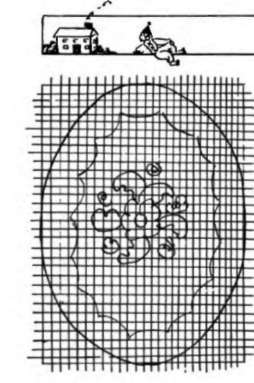
Hooked Rug
use canvas or linen.
Hook tiny loops with steel crochet hook and Shetland floss. Set loops close together. Work the design first.
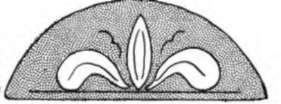
Felt Rug
cut designs from colorec felt. Paste to background.
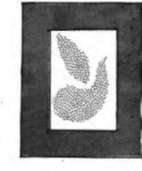

INTERIORS inc.
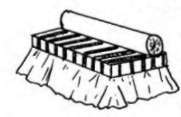
Couch And Bolster
Block of wood, 6"x4" is up-holstered as shown.Bolster is cut from fabric, 6 1/2"'x 3" Seam long sides together. Gather one end. Insert cardboard circle size of 506 piece. Stuff tube with cotton. Put in second circle. Gather second to finish. LEATHER HASSOCK.cut two circles size of 50c coin, from an old glove. Cut a strip 5"x 1". Sew long edge around one circle. Seam side. Stuff. Sew on second circle. Trim. CANOPY: crocheted in tiny filet mesh.Make about 5 1/2" wide and necessary length plus 1" for front drop. Finish with tiny tassels. COUNTERPANE, allow at least 30" for ruffle. Shirr to top piece. Roll hem edge.

Doll House Bed Linens
a. Blanket. Use fine flannel. 7"x 4". Whip the edges. Run colored wool through for trim.
b. Pillow Case. Handkerchief linen, 2"x5" Fold lengthwise. Sew top and sides. Hemstitch hem c. Sheet. Lawn or linen, 7"x6". Roll hem three sides, hemstitch fop hem. d. Mattress. Pastel percale or fine cotton. Cut two pieces, 6x4" and a strip,21"x 1". Sew strip to top, bottom pieces, leaving space to stuff. Tuft to finish, e. Quilt. Cut two pieces, 8"x8'.' Draw scallops along three sides. Sew lines before cutting. Insert thin layer of cotton.Ouilt in diagonal lines using tiny running stitches.
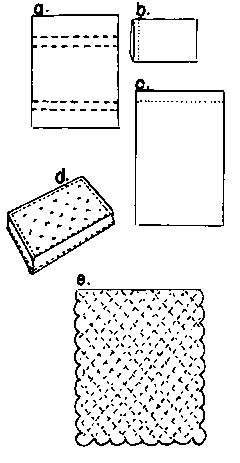
If you really want to make money with these miniatures, show some of your best work to the Shopping Editor of your newspaper. If she is impressed, she will probably write it up in her column, indicating that you will take orders for special jobs. Look for displays of miniature furniture in gift and antique shops. Show their proprietors your work and ask if you can display some of it with their displays. There are two probabilities: one, that the shop owner may want to buy the things direct from you; two, that she may display it in order to take special orders from it. In either case, be quite sure that you understand exactly what the arrangement with her is to be.
By becoming a Doll House Interior Decorator you will have hours of profitable fun ahead. Profit, in this sense, is not exclusively a money matter. A vast knowledge of periods and styles of decoration will be learned painlessly as you study books and magazines for ideas and information. Keeping abreast of modern trends, as well as learning the various periods of antique styles, is stimulating and interesting. All of it can add up to a fine background for becoming a fullfledged professional decorator later on.
Continue to:


